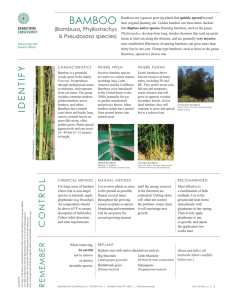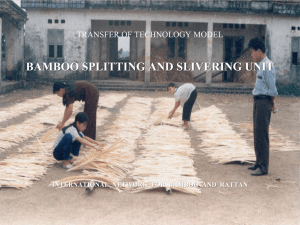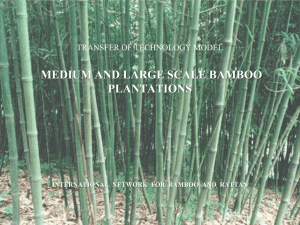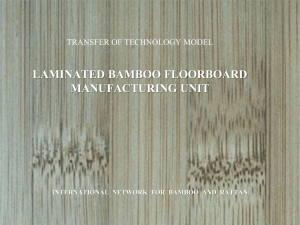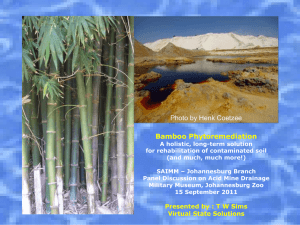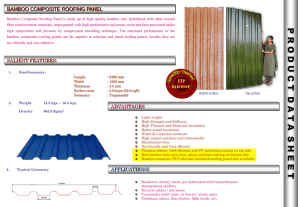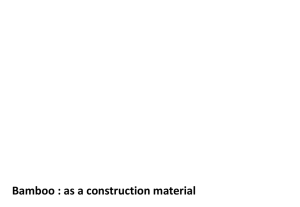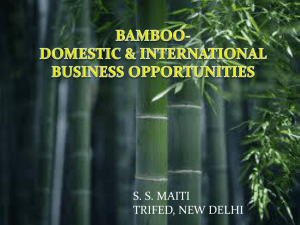Bamboos - International Network for Bamboo and Rattan
advertisement
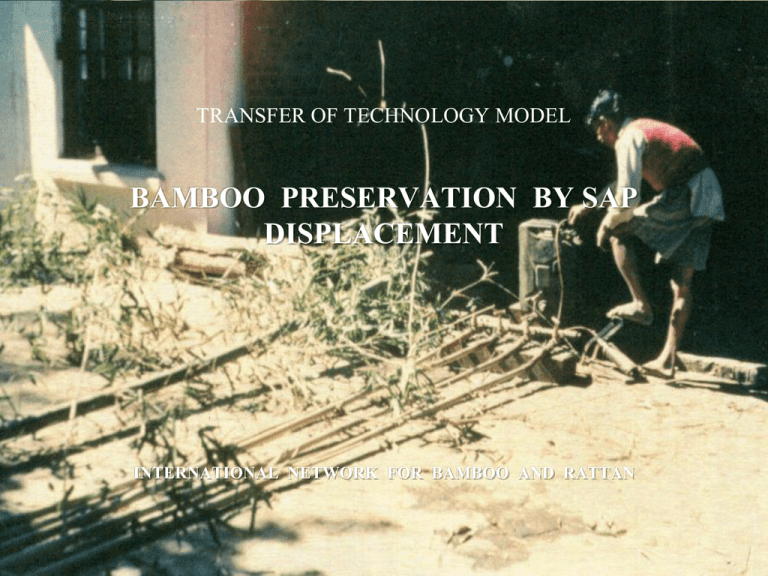
TRANSFER OF TECHNOLOGY MODEL BAMBOO PRESERVATION BY SAP DISPLACEMENT INTERNATIONAL NETWORK FOR BAMBOO AND RATTAN Why bamboo? • Bamboos grow more rapidly than trees and start to yield within three or four years of planting. • Plantation establishment requires minimal capital investment and builds upon the inherent plant-cultivation skills of local farmers and foresters. • Bamboos can be harvested annually and non-destructively. • Bamboos are excellent for rejuvenating degraded lands and protecting against soil erosion. • Bamboos may easily be intercropped with shallow-rooted crops. • As well as the culms, all other parts of the bamboo plant can be used in rural livelihoods - shoots for food, leaves for fodder, and branches for items such as brooms and for firewood. Why preserve bamboos by sap displacement methods? • Bamboos are a natural material and will decay with time. They are also susceptible to insect and fungal attack. • Preserving bamboos increases the durability of the culms and increases the lives of the products they are used to produce. It also increases the safety of any structures in which they are used as load bearing members. Preserved bamboos need to be replaced less often which reduces costs in the long term. • Sap displacement methods replace the sap in the vessels of fresh bamboos with preservative. The techniques are rapid and efficient, require minimal equipment, and the preservation mixture can be recycled. What are the main sap displacement methods? 1. Simple sap displacement: The basal 2. Modified Boucherie process: Preservative ends of the bamboo are immersed in is pumped through the bamboo from preservative for 24 - 48 hours. The the basal end. Bamboos are then bamboos are then turned upside down stored for two weeks for the and the apical ends similarly immersed. preservative to diffuse into all the cells. 3. In the conventional Boucherie process the preservative tank is held above the bamboos and the preservative passes through by gravity. Main development attributes of a sap displacement preservation unit • Reduces dependence on timber resources and thereby increases environmental protection and conservation. • Permits rehabilitation of degraded lands through increased areas of bamboo plantations. • Creates income-generating opportunities for bamboo growers who will supply the unit, and employment for unskilled and semiskilled workers at the unit. • Requires minimal capital investment to establish. • Promotes greater acceptability of bamboo, with consequent benefits for all aspects of the community involved with bamboo. Some salient facts • Bamboo culms have a life of only three years once severed from the plant, and often much less. • Sap displacement techniques are only suitable for preserving fresh bamboos, so the unit should be established no more than one day’s travel from a bamboo forest. • Preservation of bamboo is an intermediate stage between cultivation and final processing and requires good linkages to the final processors. • Treated bamboo can be sold for up to double the price of untreated bamboo. • As a primary processing activity the preservation unit is ideally established as one of the central core units in a broader, community-based, bamboo development programme, along with a bamboo splitting and slivering unit and a bamboo propagation unit. Photo: Demonstrating the conventional (or simple) Boucherie technique Requirements for success • Sustained supply of fresh bamboos within one day’s travel of the unit. • Some technically-trained personnel to manage and maintain the unit. • A small amount of start up capital. • Proper linkages to the users of the treated culms. Right: Schematic diagram of the conventional Boucherie process. Financial aspects of a sap displacement unit START UP COSTS (US Dollars) • Steel drum for steeping and sap displacement. $5 • Steel tank for diffusion or masonry tank for diffusion. $500 $200 • Boucherie equipment. (for 50 bamboos at a time) $500 Additional cost of treating bamboo: RUNNING COSTS • Bamboo purchase 10-15 cents/m • Treatment cost 5-8 cents/m 15-20% Increase in service life of treated bamboo: 3 - 5 times Above: Hut made of treated bamboo. For further information See TOTEMs Village bamboo preservation unit. Rattan oil curing, bleaching and preservation. Websites INBAR: www.inbar.int IWST Bangalore: www.iwst.res.in Contact • INBAR, Beijing 100101-80, China • Institute of Wood Science and technology (IWST), 18th Cross, Malleswaram, Bangalore, 560 003, India Books Bamboo Preservation Techniques A Review. 1994. By Sathish Kumar, K.S. Shukla, Indra Dev, P.B. Dobriyal. Published by INBAR / ICFRE (available as text file at: http://www.inbar.int/publication/publmain.asp?catecode=pp)
